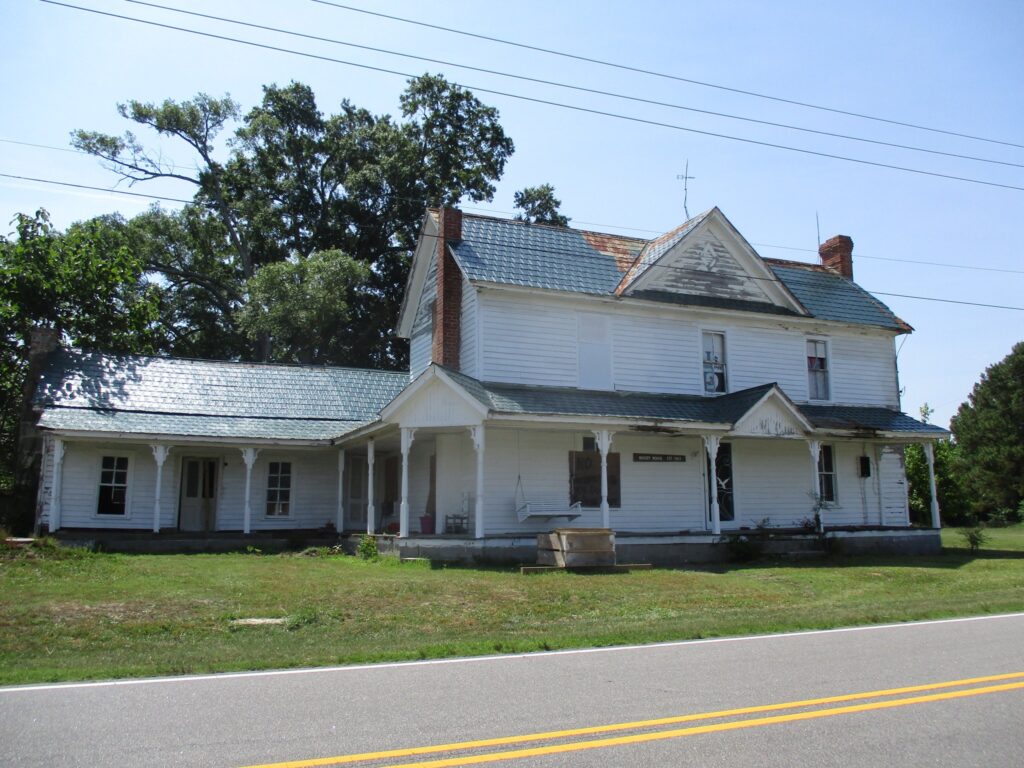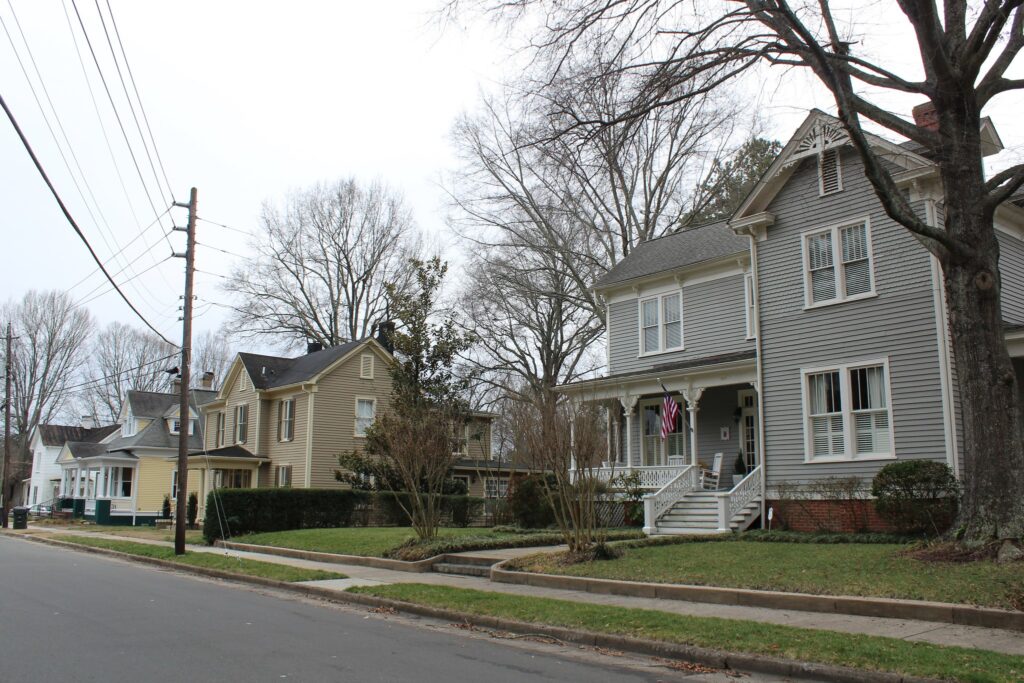From WSJ Staff Reports
One local historic district and one local individual property has been added to the National Register of Historic Places. The Oxford Historic District, in Granville County and the Peace-Stallings-Massey House, near Pilot in Franklin County, were named along with three other historic districts and three other historic properties,
The properties were reviewed by the North Carolina National Register Advisory Committee and subsequently nominated by the North Carolina State Historic Preservation Officer and forwarded to the Keeper of the National Register for consideration for listing in the National Register.
“The National Register of Historic Places is a vital tool in preserving our state’s treasured historical resources,” said Reid Wilson, secretary of the N.C. Department of Natural and Cultural Resources. “Each time we add new districts and properties to the register, we recognize and celebrate North Carolina’s rich and diverse history.”
The listing of a property in the National Register places no obligation or restriction on a private owner using private resources to maintain or alter the property. Over the years, various federal and state incentives have been introduced to assist private preservation initiatives, including tax credits for the rehabilitation of National Register properties. As of Jan. 1, 2020, over 4,036 historic rehabilitation projects with an estimated private investment of over $3.216 billion have been completed in the state.
The following districts and properties were added to the National Register:
Eastern North Carolina
• Winton Historic District, Winton, Hertford County, listed 12/21/2020
The Winton Historic District includes the majority of extant late-19th and early-20th century resources in the town, illustrating the growth of the town after the Civil War, during which time the entire town was burned. The Winton Historic District is locally significant in the area of commerce. Winton served as an important commercial hub for cotton, peanut and corn farmers in Hertford and surrounding counties. The district is also locally significant in the areas of politics and government as the county seat of Hertford County since 1766. Together with the courthouse, the 1950-1951 Hertford County Office Building and Hertford County Health Department remain the center of county government, which is one of Winton’s primary employers. The Winton Historic District is also locally significant under Criterion A for Native American Ethnic Heritage, African American Ethnic Heritage, and Education. The C.S. Brown School opened in 1886 as Chowan Academy, a boarding school for students of color and the only high school for students of color in Hertford County until 1937. Finally, the Winton Historic District is significant at the local level for architecture, as it contains residential, commercial, governmental, and institutional buildings in styles and forms that illustrate national trends.
Central North Carolina
• Country Club Estates Historic District, Mount Airy, Surry County, listed 12/22/2020
The Country Club Estates Historic District is significant in the area of historic architecture for its quality and diversity, representing a range of types, periods and methods of construction. The district encompasses a residential neighborhood that developed beside the Mount Airy Country Club, shortly after the club was established 1927. It contains a relatively intact collection of Colonial Revival, Tudor Revival, and Ranch houses, and houses in other styles including the ca. 1946 Natt and Ruth Ferguson House, an International Style residence that is one of Mount Airy’s earliest Modernist houses. The neighborhood was one of Mount Airy’s first suburban developments and among the first to feature curvilinear planning, the realization of a design by surveyor Phillip H. Haskins.
- Ingleside, Huntersville, Mecklenburg County, listed 12/15/2020
Ingleside, an exceptionally intact and rare mid-19th-century residence in rural Mecklenburg County, is architecturally significant as one of the county’s very few extant and largely unaltered examples of the transitional Greek Revival-Italianate style. The double-pile weatherboarded dwelling manifests common Greek Revival-Italianate characteristics such as a low hip roof, symmetrical fenestration, large multipane double-hung wood sash, deep eaves and flat corner pilasters. The robust Tuscan parged brick columns and pilasters that support the one-story, low-hip-roofed porch are classical elements, while the eave brackets reflect a picturesque influence. Primary rooms retain original volumes and finishes such as smooth plaster walls and ceilings; molded wood cornices, chair rails, window and door surrounds; wood panels beneath windowsills; baseboards with molded upper edges; post-and-lintel mantels, heart-pine floors, and single-leaf six-panel doors. While Ingleside’s architect and builders remain unidentified and its precise construction date yet undetermined, oral tradition indicates that the house was finished soon after the Civil War, perhaps in preparation for Dr. William Speight McLean Davidson’s March 8, 1866, marriage to Mary E. Johnston.
- Lebanon Hill Historic District, Mount Airy, Surry County, listed 12/22/2020
The Lebanon Hill Historic District is a predominately residential neighborhood located on the north side of the historic downtown of Mount Airy, N.C., a community which underwent rapid development following the arrival of the railroad in the 1880s. The district is significant in the area of architecture for its quality and diversity, representing a range of types, periods and methods of construction. The approximately 70-acre district takes its name from the neighborhood’s highest elevation Lebanon Hill, named for the antebellum Lebanon Methodist Church which stood on or near the hill. Residential construction began around 1890, as demonstrated by the Eugene Smith House, a Shingle Style-influenced Queen Anne residence believed to be the oldest building in the district. Other house styles and types were introduced in the early and mid-20th century, including the Craftsman, Colonial Revival, Tudor Revival, Period Cottage, Minimal Traditional, Moderne, and Ranch styles, as well as a number of modest, minimally detailed dwellings, particularly the one-story, two-room-deep, hip-roofed cottage. The district’s few non-residential buildings include Holy Angels Catholic Church, a Gothic Revival granite chapel built in 1921, and the late 1940s Dairy Center restaurant, a simple roadside Modernist building.
- Oxford Historic District (Additional documentation, boundary decrease, boundary Increase), Oxford, Granville County, listed 12/21/2020
Building on the original 1988 Oxford Historic District nomination, this nomination provides updates through Additional Documentation, a Boundary Decrease and a Boundary Increase. Oxford, the Granville County seat, became an important commercial hub in the county with a booming tobacco market and contains an impressive collection of commercial, residential, ecclesiastical, industrial, and institutional buildings in nationally popular architectural styles from the early 1800s through the late-1960s. The Period of Significance for the original district ended in 1937, yet Oxford continued to grow and prosper into the next few decades. Through the Additional Documentation, the new nomination includes additional historic background, and expanded architectural context, and commercial context for the period from 1937 through the late 1960s. The Boundary Increase expands the district in 12 areas and includes residential and commercial development of Oxford through the mid-20th century as well as the worker housing and historically African American residences, churches and education buildings that contributed to Oxford’s rich and diverse history. The minimal Boundary Decrease excludes a single vacant lot which was formerly the site of the L. H. Currin American Tobacco Company Prize House. The updated district more accurately reflects the full scope of Oxford’s history, as well as 20th century building trends, including more modestly scaled and detailed early to mid-20th century houses and commercial buildings.
- Pearce-Stallings-Massey House, Pilot vicinity, Franklin County, listed 12/30/2020
The Pearce-Stallings-Massey House is locally significant for architecture as it embodies the distinctive characteristics of types, periods and methods of construction from the early 19th to the early 20th century in Franklin County through the combination of typologies and forms in a single “evolved house.” Its Period of Significance spans from circa 1820, the estimated date of original construction, to circa 1910 the estimated date of the last major building campaign. The Pearce-Stallings-Massey House, which has remained in the same family since it was built, is a good example of an evolved house including in a single residence a hall-parlor dwelling, a rear kitchen ell, and a Triple-A I-house, all vernacular forms common to the region.
Western North Carolina
- Harmon School, Laurel Springs vicinity, Wilkes County, listed 12/29/2020
Completed in 1921 in a remote, mountainous, and thinly settled area of Wilkes County, the Harmon School is significant for its role as an experiment in transition away from the poor design of most one-room, rural schools during the early 20th century. The Harmon School is also significant as a well-preserved example of a rural, frame, one-room schoolhouse with a partition wall that could divide the space into two classrooms. The school served the educational needs of the surrounding rural community until 1954, when the Wilkes County Board of Education sold the school and small parcel of land as surplus property.
- Southern Railway Freight Station, Morganton, Burke County, listed 12/29/2020
The Southern Railway Freight Station was erected in 1929 in response to the growing industrial transportation needs of manufacturers in Morganton, Burke County. The property is significant not only as an excellent and intact example of a freight station with modest Colonial Revival-style features, but also for the role that it played in the burgeoning industrial sector—particularly growth in the textile and furniture industries—in the Piedmont community. The Southern Railway ceased freight operations at this site circa 1970.
About the National Register of Historic Places
The National Register of Historic Places is the nation’s official list of buildings, structures, objects, sites, and districts worthy of preservation for their significance in American history, architecture, archaeology, and culture. The National Register was established by the National Historic Preservation Act of 1966 to ensure that as a matter of public policy, properties significant in national, state, and local history are considered in the planning of federal undertakings, and to encourage historic preservation initiatives by state and local governments and the private sector. The Act authorized the establishment of a State Historic Preservation Office in each state and territory to help administer federal historic preservation programs.
In North Carolina, the State Historic Preservation Office is a unit of the North Carolina Department of Natural and Cultural Resources. The North Carolina National Register Advisory Committee, a board of professionals and citizens with expertise in history, architectural history, and archaeology, meets three times a year to advise the State Historic Preservation Officer on the eligibility of properties for the National Register and the adequacy of nominations.


